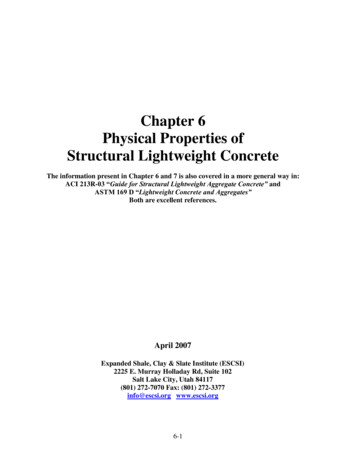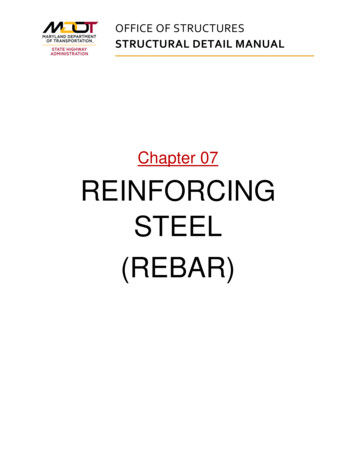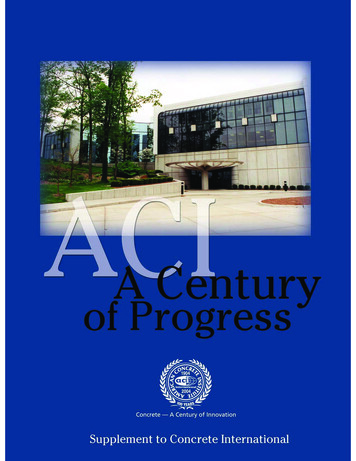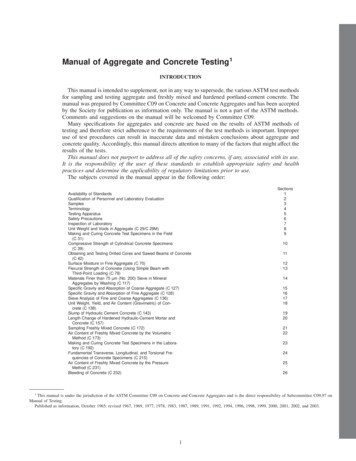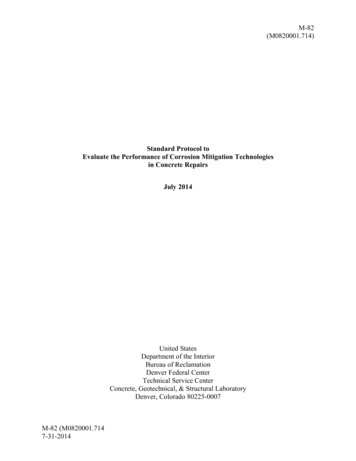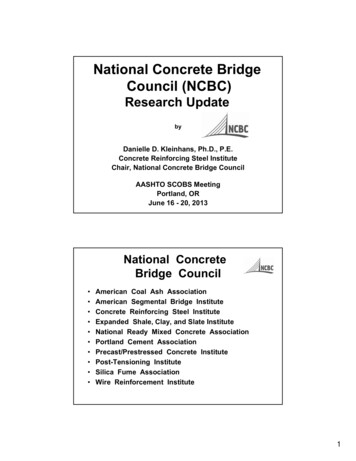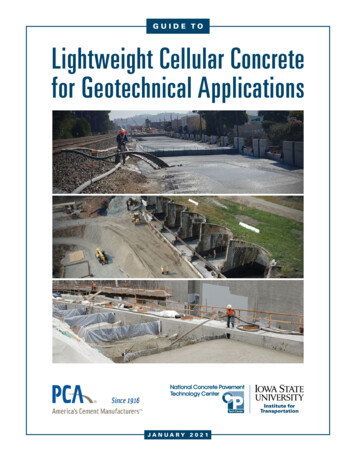
Transcription
GUIDE TOLightweight Cellular Concretefor Geotechnical ApplicationsJANUARY 2021
About the CP Tech CenterThe mission of the National Concrete PavementTechnology Center (CP Tech Center) at Iowa StateUniversity is to unite key transportation stakeholdersaround the central goal of advancing concrete pavementtechnology through research, tech transfer, andtechnology implementation.About the PCAThe Portland Cement Association (PCA) is a nonprofitorganization founded in 1916 that serves America’scement manufacturers through policy, research,education, and market intelligence. PCA membersrepresent 91 percent of US cement productioncapacity with facilities in all 50 states. PCA promotessafety, sustainability, and innovation in all aspects ofconstruction, fosters continuous improvement in cementmanufacturing and distribution, and generally promoteseconomic growth and sound infrastructure investment.DisclaimersNeither Iowa State University nor the Portland CementAssociation nor this document’s authors, editors,designers, illustrators, distributors, or technical advisorsmake any representations or warranties, expressed orimplied, as to the accuracy of information herein anddisclaim liability for any inaccuracies.This publication is provided solely for the continuingeducation of qualified professionals. This publicationshould only be used by qualified professionals whopossess all required licenses, who are competentto evaluate the significance and limitations of theinformation provided herein, and who accept totalresponsibility for the application of this information.Iowa State University does not discriminate on the basisof race, color, age, ethnicity, religion, national origin,pregnancy, sexual orientation, gender identity, geneticinformation, sex, marital status, disability, or status asa US Veteran. Inquiries regarding nondiscriminationpolicies may be directed to the Office of EqualOpportunity, 3410 Beardshear Hall, 515 Morrill Road,Ames, Iowa 50011, telephone: 515-294-7612, hotline:515-294-1222, email: eooffice@iastate.edu.About this GuideThis document, Guide to Lightweight Cellular Concretefor Geotechnical Applications, provides information onthe materials, properties, design, proper handling, andapplications of lightweight cellular concrete (LCC) forgeotechnical applications.While this document may not address all of a project’sspecific details, it provides information for constructionprofessionals and design engineers on the use of LCCin geotechnical applications, including common uses,conceptual guidance, and design guidelines. Theapplications presented in this guide have exhibitedgood long-term performance, providing cost-effectivesolutions and better and safer designs for projects acrossNorth America.This document includes, as an appendix at the end ofit, a guide specification covering materials, equipment,construction inspection, and testing requirements forconstructing LCC fills.Reference Information for this GuideTaylor, S. and G. Halsted. 2021. Guide to LightweightCellular Concrete for Geotechnical Applications. PortlandCement Association, Washington, DC, and NationalConcrete Pavement Technology Center at Iowa StateUniversity, Ames, IA. 2021 Portland Cement AssociationFront Cover Image CreditsTop: Throop Lightweight Fill, used with permissionCenter: Cell-Crete Corporation, used with permissionBottom: Portland Cement AssociationFor More InformationFor technical assistance regarding cement-based concretepaving, contact the Portland Cement Association or theCP Tech Center:Greg Halsted, ManagerPavements and Geotechnical MarketsPortland Cement Association200 Massachusetts Avenue NW, Suite 200Washington, DC .org/Peter Taylor, DirectorNational Concrete Pavement Technology CenterIowa State University2711 S. Loop Drive, Suite 4700Ames, IA techcenter.org
Technical Report Documentation Page1. Report No.2. Government Accession No.3. Recipient’s Catalog No.PCA Special Report SR1008P4. Title and Subtitle5. Report DateGuide to Lightweight Cellular Concrete for Geotechnical ApplicationsJanuary 20216. Performing Organization Code7. Author(s)8. Performing Organization Report No.Scott Taylor and Greg Halsted9. Performing Organization Name and Address10. Work Unit No.National Concrete Pavement Technology CenterIowa State University2711 South Loop Drive, Suite 4700Ames, IA 50010-866411. Contract or Grant No.12. Sponsoring Organization Name and Address13. Type of Report and Period CoveredPortland Cement Association200 Massachusetts Avenue NW, Suite 200Washington, DC 2000114. Sponsoring Agency CodeGuide15. Supplementary NotesVisit https://cptechcenter.org for color pdfs of this and other publications.16. AbstractThe primary purpose of this guide is to provide information on the materials, properties, design, proper handling, and applicationsof lightweight cellular concrete (LCC) for geotechnical applications.LCC is a mixture of portland cement and water slurry, combined with preformed foam to create air voids, that can act as a strong,lightweight, durable, and inexpensive alternative to soil or fill replacement for many geotechnical applications. LCC’s lightweightproperty reduces ground settlement and improves the bearing capacity and the static and seismic stability of embankments.Given that an LCC mix is highly flowable, it can be efficiently and safely placed in confined or problematic spaces such as in pipes,trenches, tunnels, wall backfills, and other areas where the routine placement of earthen fill is difficult, if not impossible. Theseattributes make LCC a low-cost solution for many geotechnical applications.While this document may not address all of a project’s specific details, it provides information for construction professionalsand design engineers on the use of LCC in geotechnical applications, including common uses, conceptual guidance, and designguidelines. The applications presented in this guide have exhibited good long-term performance, providing cost-effective solutionsand better and safer designs for projects across North America.Among other topics, this guide provides examples of both mix design preparation and field installation, geotechnical evaluation,and the design, construction, and field testing of LCC. Throughout, this guide addresses the importance of geotechnicaloversight at the beginning of a project, during the mix design stage, and during construction to ensure that the project meets itsintended purpose.17. Key Words18. Distribution Statementgeotechnical solutions—LCC design guidelines—LCC geotechnicalexamples—LCC geotechnical guidance—lightweight cellular concreteNo restrictions.19. Security Classification(of this report)20. Security Classification(of this page)21. No. of Pages22. PriceUnclassified.Unclassified.58NA
Guide to Lightweight Cellular Concretefor Geotechnical ApplicationsJanuary 2021AuthorsScott M. Taylor, P.E.Greg E. Halsted, P.E., Portland Cement AssociationManaging EditorOksana GiesemanGraphic Design, Layout, and ProductionAlicia HoermannCopyeditorsSue Stokke and Peter HunsingerSponsored by 2021 Portland Cement AssociationA guide fromNational Concrete Pavement Technology CenterIowa State University2711 South Loop Drive, Suite 4700Ames, IA 50010-8664Phone: 515-294-5798 / Fax: 515-294-0467https://cptechcenter.org
ivGuide to Lightweight Cellular Concrete for Geotechnical Applications
ContentsAcknowledgments Executive Summary Chapter 1. Introduction Background of Lightweight Cellular Concrete viii133Chapter 3. Geotechnical DesignConsiderations Settlement Reduction/Weight Reduction 2020Net Load Design Method for Settlement Reduction 20Definition of LCC 3Bearing Capacity 22Scope of This Guide 3Punching Shear 23Benefits 3Buoyancy 24Applications 4Pavement Bases and Subbases 26Lightweight Road Subbases and Fills 4Retaining Wall Backfill Soil Pressures 26Bridge Approach Embankments 5Drainage 26Void and Cavity Filling 6Abandoned Pipe and Culvert Filling 6Chapter 4. Mixture Design Ingredients 2727Annular Space Grout Filling 7Portland Cement 27Foundation Fills 8Water 27Energy Arresting Systems 8Air 28Retaining Walls and Precast Wall Panels 8Foaming Agents 28Lightweight Dam and Levee Structural Fills 9Water/Cement Ratio 28Landslide Repair and Slope Stabilization 9Mix Design Example (Trial and Error Procedure) 2810Laboratory Sample Preparation 301111Chapter 5. Construction Specifications 3232Cast Density 11Property Requirements 32In-Place Density 11Subgrade and Subbase Preparation 32Oven-Dry Density 11Field Observations 33Viscosity 12Reinforcement 33Lateral Fluid Pressure 12Transportation 33Set Time 12Placement and Consolidation 3413Finishing 34Controlled Density Fill Chapter 2. Physical Properties Fresh Properties Hardened Properties Hardened Description 13Surface Finishes 34Strength 13Curing and Protection 35Cohesion and Friction Angle 14Weather Conditions 35Modulus of Elasticity 15Timing 35Air Content 15Field Equipment 35Drying Shrinkage 15Batch Mixing 36Permeability/Sorption 16High-Shear Batching 36Heat of Hydration 16Auger Mixing/Mobile Volumetric Mixers 36Thermal Conductivity 18Cement Delivery 37Resistance to Aggressive Environments 19Ready-Mixed Concrete Plants 37Guide to Lightweight Cellular Concrete for Geotechnical Applicationsv
Pumping Devices 37Progressive Cavity Pump 38Peristaltic Pump 38Piston Pump 38Chapter 6. Inspection, Testing, andMaintenance Field Quality Control Testing 3939Field Quality Control Observation 40Post-construction Inspection and Testing 40Compressive Strength Testing 41Maintenance 41viReferences 43Appendix. Guide Specification for Constructionof Lightweight Cellular Concrete Fill 45Guide to Lightweight Cellular Concrete for Geotechnical Applications
FiguresTablesFigure 1.1. Pavement structure comparison 4Table 2.1. Physical properties of LCC 13Figure 1.2. Lightweight road subbases and fills (Ohio) 5Table 2.2. Friction angles and cohesion values for LCC 14Figure 1.3. Bridge approach embankments (Indiana) 5Table 2.3. Modulus of elasticity relationships of LCC 15Figure 1.4. Void and cavity filling (Alberta) 6Figure 1.5. Pipe and culvert abandonment filling(Michigan) Table 2.4. Summary of cellular concrete hydraulicconductivity testing 166Figure 1.6. Annular space grout filling (Maine) 7Figure 1.7. Ungrouted and grouted annular spaces 7Table 2.5. Calculated heat capacity and thermalconductivity of foamed concrete mixes, 300 kg/m3portland cement content, silica sand fine aggregate 17Figure 1.8. Foundation fills (Florida) 8Table 2.6. Thermal properties of LCC at differentdensities 18Figure 1.9. Energy arresting systems (West Virginia) 8Table 4.1. Portland cement types 27Figure 1.10. Placing LCC backfill behind precast wallpanels (California) 9Table 4.2. Blended hydraulic cement types 27Table 4.3. Hydraulic cement performance attributes 27Figure 1.11. Lightweight dam and levee structural fills(California) 9Figure 1.12. Landslide repair and slope stabilization(California) 9Figure 1.13. Controlled density fill 10Figure 2.1. Vesicles/air voids 13Figure 3.1. Net load design method for settlementreduction 21Figure 3.2. Bearing capacity and spread of compressiveforces in LCC 23Figure 3.3. Punching shear resistance in LCC layer 24Figure 3.4. Buoyancy considerations in an LCC layer 25Figure 4.1. Preformed foam generator 31Figure 5.1. Prepared subgrade awaiting LCC placement 32Figure 5.2. Welded wire mesh in an LCC placement 33Figure 5.3. How foam is introduced into a ready-mixedconcrete truck-based pumping system 34Figure 5.4. Surface of in-place LCC fill 35Figure 5.5. Batch mixer 36Figure 5.6. Mobile volumetric mixer 36Figure 5.7. Inline foam additive system 37Figure 5.8. Ready-mixed concrete truck 37Figure 5.9. Progressive cavity pump 38Figure 6.1. Sampling/testing LCC in the field(Michigan) 39Figure 6.2. Surface of recently placed LCC 40Figure 6.3. Unconfined compressive strength testing ofLCC 41Guide to Lightweight Cellular Concrete for Geotechnical Applicationsvii
AcknowledgmentsThe authors, the National Concrete Pavement Technology (CP Tech) Center, and the Portland Cement Associationgratefully acknowledge the contributions of the technical contributors and the technical advisory committee (TAC)members, who helped establish the technical direction for the guide and reviewed several drafts. Their feedback andsuggestions were invaluable. Wayne Adaska, Portland Cement Association(formerly) * Steven Bartlett, University of Utah * James Krstulovich, Illinois Department of Transportation Tarja Kyllönen, Runway Safe Group Steve Bent, CEMATRIX Roberto Montemayor, University of Illinois atUrbana-Champaign Jacques Bloomfield, The Reinforced Earth Company * Gordon Smith, National CP Tech Center * Tyler Bodnar, California Nevada Cement Association Nico Sutmoller, Aerix Industries Tony Borglum, Richway Industries, Ltd. Binod Tiwari, California State University, Fullerton * Jesse Downs, Strong Manufacturing Trevor Towery, Elastizell Corporation of America * Milton Gomez, Aerix Industries * Diego Villegas, Cell-Crete Corporation Ray Henn, RW Henn LLC * Jeff Wykoff, California Nevada Cement Association(formerly) * Craig Hrkal, Cellular Concrete Inc. * Jon (Ike) Isaacson, Brierley Associates Corporationviii* TAC membersGuide to Lightweight Cellular Concrete for Geotechnical Applications
Executive SummaryThe primary purpose of this guide is to provideinformation for construction professionals and designengineers on the materials, properties, design, properhandling, and applications of lightweight cellular concrete(LCC) for geotechnical applications, including commonuses, conceptual guidance, and design guidelines. Thisguide does not cover the properties or uses of LCC forroof deck systems, autoclaved aerated cellular concrete forcreating lightweight precast items, or lightweight structuralconcrete for reducing the dead loads to concrete elements.This guide also does not discuss the use of permeablelow-density cellular concrete or cellular concrete having anoven-dry density greater than 50 lb/ft3 (800 kg/m3).Initially used as a construction product for flooringsystems in both Europe and the United States duringthe first part of the 20th century, LCC was eventuallygranted a patent in 1934. Since then, the commercialuse of LCC has grown into the industry it is today, withmany types of applications in a variety of fields.LCC is a mixture of portland cement and water slurry,combined with preformed foam to create air voids,that can act as a strong, lightweight, durable, andinexpensive alternative to soil or fill replacement for manygeotechnical applications. Its lightweight property reducesground settlement and improves the bearing capacity andthe static and seismic stability of embankments.Given that an LCC mix is highly flowable, it can beefficiently and safely placed in confined or problematicspaces such as in pipes, trenches, tunnels, wall backfills,and other confined areas where the routine placement ofearthen fill is difficult, if not impossible. These attributesmake LCC a low-cost solution for many geotechnicalapplications.While this document may not address all of a project’sspecific details, this guide provides examples of both mixdesign preparation and field installation, geotechnicalevaluation, and the design, construction, and field testingof LCC, among other topics. Throughout, this guideaddresses the importance of geotechnical oversight at thebeginning of a project, during the mix design stage, andduring construction to ensure that the project meets itsintended purpose.The six chapters in this guide cover the followinginformation: Chapter 1. IntroductionChapter 1 covers the scope of the guide, provides adefinition of and background for LCC, describes thebenefits of using LCC for geotechnical applications,and lists many of those applications. Chapter 2. Physical PropertiesChapter 2 covers both the fresh and hardenedproperties of LCC and the importance of theseproperties in geotechnical applications. Chapter 3. Geotechnical Design ConsiderationsChapter 3 covers the important engineering designprinciples required for consideration of LCC ongeotechnical projects. Chapter 4. Mixture DesignChapter 4 covers the ingredients of LCC and theprocess used to determine the proper cement, water,and air content for LCC and includes information onlaboratory sample preparation. Chapter 5. ConstructionChapter 5 discusses the requirements and process forconstructing an LCC fill, the equipment and proceduresrequired, and field observations to ensure quality. Chapter 6. Inspection, Testing, and MaintenanceChapter 6 provides information on field quality controltesting and observation, post-construction inspectionand testing, and maintenance.The following appendix is included at the end of this guide: Appendix. Guide Specification for Construction ofLightweight Cellular Concrete FillThe appendix provides a guide specification coveringmaterials, equipment, construction inspection, andtesting requirements for constructing LCC fills.Executive Summary1
2Guide to Lightweight Cellular Concrete for Geotechnical Applications
Chapter 1. IntroductionBackground of Lightweight CellularConcreteInitially used as a construction product for flooringsystems in both Europe and the United States during thefirst part of the 20th century, lightweight cellular concrete(LCC) was eventually granted a patent in 1934 (Bayer v.Rice 1934). Since then, the commercial use of LCC hasgrown into the industry it is today, with many types ofapplications in a variety of fields.Definition of LCCLCC is a mixture of portland cement and water slurry,combined with preformed foam to create air voids, thatcan act as a strong, lightweight, durable, and inexpensivealternative to soil or fill replacement for geotechnicalapplications. The American Concrete Institute (ACI)Committee 523, which provides information onmaterials, fabrication, properties, design, and handling ofthe product, defines this material in its Guide for Cast-inPlace Low-Density Cellular Concrete as follows:Concrete made with hydraulic cement, water, andpreformed foam to form a hardened material havingan oven-dry density of 50 lb/ft3 (800 kg/m3) or less.These mixtures may include aggregate and othermaterial components including, but not limited to,fly ash and chemical admixtures. (ACI 2006)The key is obtaining a homogenous and stable air void orcell structure. The cellular structure is attained essentiallyby the inclusion of macroscopic voids (air bubbles)resulting from the mechanical incorporation of air orother gases.In addition to LCC, many other terms are often usedto describe this material, including low-density cellularconcrete (LDCC), foam concrete, and controlledlow-strength material (CLSM) (ACI 2006). To avoidconfusion and be consistent, the term used throughoutthis document, unless specifically noted otherwise, isLCC, as it is the best descriptor for the product, is notbrand specific, and clearly and appropriately identifiesthe material.Scope of This GuideThis guide provides information for constructionprofessionals and design engineers on the materials,properties, design, proper handling, and applications ofLCC for geotechnical applications, including commonuses, conceptual guidance, and design guidelines. Thisguide does not cover the properties or uses of LCC forroof deck systems, autoclaved aerated cellular concretefor creating lightweight precast items, or lightweightstructural concrete for reducing the dead loads toconcrete elements. This guide also does not discuss theuse of permeable low-density cellular concrete or cellularconcrete having an oven-dry density greater than 50 lb/ft3(800 kg/m3).BenefitsThe four primary benefits of LCC for geotechnicalapplications are as follows: Significantly lighter in weight than soil Highly flowable and able to fill spaces of any size orshape Often less expensive than many alternative systems Can accelerate construction schedulesThe lightweight property of LCC reduces groundsettlement and improves the bearing capacity and thestatic and seismic stability of embankments when usedas a lightweight fill placed on top of soft, compressiblesoils. Also, given that an LCC mix is highly flowable(even over long distances), it can be efficiently and safelyplaced in confined or problematic spaces such as in pipes,trenches, tunnels, wall backfills, and other areas where theroutine placement of compacted earthen fill is difficult,if not impossible. These attributes make LCC a low-costsolution for many geotechnical applications.Chapter 1. Introduction3
The rapid placement and reasonably fast setting timeof LCC expedite construction operations. Many otherattributes of LCC provide additional advantages forspecific challenges, including the following:course at the surface, placed over base and/or subbaselayers (typically crushed stone or stabilized materials),and underlaid by a compacted earthen subgrade (seeFigure 1.1). Aggregate conservationThese pavement systems have proven to work successfullyin stable soil and foundation conditions, providing apavement that is durable and long-lasting. However,when the soil and site conditions are less than optimal,placing a layer of strong, lightweight LCC can strengthenand overcome many of the challenges posed by poorsubgrade materials (soft or expansive clays, collapsible orreactive soils, etc.). The primary design consideration foruse of LCC in these situations is weight compensation. Insulation Freeze-thaw resistance Self-leveling and consolidating Energy dissipation and damping Density, strength, and permeability control Ability to be excavated Inert/nonflammable Local availability Ease of pumping Dynamic properties Reduced transportation costs and emissions Increased worker safetyThis guide discusses the segments of the geotechnicalmarketplace where LCC has been successfully used andreviews the above properties, functions/advantages,and benefits. The LCC applications presented in thisguide have exhibited excellent long-term performance,providing cost-effective solutions and better and saferdesigns for projects across North America.ApplicationsLightweight Road Subbases and FillsMost modern roadways consist of a structural pavementsection comprised of a concrete or asphalt riding/wearingThe displacement of soft compressible soil is generallydue to excessive loads applied to these soils. LCC can beutilized as a full or partial replacement for the subbaselayer in these applications to produce a zero or low netload increase to the foundation soil.Geotechnical engineers perform pavement thickness,weight reduction, and embankment stability calculations,obtained primarily from laboratory testing, usingrepresentative material properties and unit weights for therespective materials and soils. These calculations must alsoaccount for possible roadway elevation and groundwaterchanges from seasonal cycles or construction dewateringin addressing construction and long-term loadingconfigurations. In this document, this determination ofload balancing of the pavement/embankment systemis referred to as the net load design method and isfurther described in Chapter 3. This method is used toensure the short- and long-term stability and settlementperformance of the roadway system.National CP Tech CenterFigure 1.1. Pavement structure comparison4Guide to Lightweight Cellular Concrete for Geotechnical Applications
2002 Elastizell Corporation of America, used with permissionFigure 1.2. Lightweight road subbases and fills (Ohio)The benefits of this geotechnical structural solutionfor an actively settling roadway begin with its expectedlong-term performance with little or no settlement. Byinstalling an inert, engineered, lightweight cementitiouslayer or embankment of material with an unconfinedcompressive strength that is up to 5 to 10 times strongerthan a typically compacted soil or granular material, thesubbase is both strengthened and reduced in weight.In addition, this practical solution produces a relativelystrong, self-consolidating roadway subbase material thatincreases the pavement life and greatly diminishes thepotential for significant settlement (see Figure 1.2).Another benefit of installing LCC as opposed to otheralternatives is that it typically takes less time andequipment to install, which can result in significant costand time savings, especially when compared to a solutionrequiring massive surcharge loadings of embankmentfoundations, which can take many months. Because LCCis a highly flowable material that is also self-consolidatingand self-leveling, it eliminates the need to compact andlevel the subgrade before it is placed. These propertiesreduce the need for extra equipment and labor at a jobsite.upward as it nears the bridge, causing the likelihood ofsettlement to increase and warranting a higher factorof safety (FOS) and greater designed LCC thickness toresolve the settlement potential. If not addressed duringthe design and construction phases, long-term differentialconsolidation settlement of the foundation soils canoccur, often creating a bump at the bridge, which istypically found between the abutment and the approachslab. This settlement can lead to potential safety hazardsand cause comfort issues for drivers, as well as lead to anincreasing rate of structural deterioration and long-termmaintenance costs for the roadway.Estimates show that bridge approach slab problems affectabout 25% of the bridges in the US (Briaud et al. 1997).A more recent report (2017) from the Federal HighwayAdministration (FHWA) states that about 9% of theover 600,000 bridges in the US are structurally deficient.Undoubtedly, many of these bridges are affected byapproach settlement, or the bump. Fortunately, when softand compressible ground conditions are encountered, theweight reduction function of LCC can resolve the soilissues, eliminating the bump at the bridge without theneed for more costly soil remediation methods.Just like road subbases and fills, another benefit ofinstalling LCC for bridge approach embankments is thatinstallation typically takes less time and equipment thanalternative solutions, which can result in significant costand time savings.Other design and construction considerations whenselecting LCC are the width of the embankment andwhether side slopes for vegetation or retaining walls areused. Sloping LCC embankments are typically constructedwith a stepped surface below the finished grade (see Figure1.3) and capped with about 2 ft (0.6 m) of soil placed overthe top to create a vegetative landscape surface.Lastly, this application of LCC is also environmentallyfriendly, in that the imported LCC fills provide 130 yd3(100 m3) per delivered load of dry cement while soil andgranular fills provide only 10 to 15 yd3 (8 to 11 m3) perload. The reduced trucking significantly reduces CO2emissions and traffic congestion, pavement wear, andnoise. It also reduces the use of scarce natural resources.Bridge Approach EmbankmentsBridge approaches are elevated pavement sections comingup to the edge of a bridge abutment. The correspondingLCC approach embankments are designed using the netload design method, often using strict design criteriaand performance requirements. The challenge is thatthe typical height of the approach embankment slopes 1993 Elastizell Corporation of America, used with permissionFigure 1.3. Bridge approach embankments (Indiana)Chapter 1. Introduction5
When designing retaining walls or abutments with LCCbackfill, the lateral loads on the structures are reduced,allowing for the use of less costly systems. This loadreduction can often lead to significant cost savings on thewalls, foundations, and internal reinforcement.The use of LCC as an embankment fill has been provensuccessful in many situations. Typical projects includelarge freight rail grade separation structures constructedusing large volumes of LCC paired with precast concretepanel systems. On these types of projects, LCC is used asthe “lightweight soil” replacement in the structural andgeotechnical designs.Void and Cavity FillingOne of the most common reasons for using LCC is itshighly flowable property. The air bubbles added to thecement paste act like tiny ball bearings within a voidor cavity, allowing the material to flow rapidly into allavailable spaces. Once all water has been removed fromthe voids prior to starting, the highly flowable natureof LCC allows for easy pumping and long-distancetransportation in hoses, which results in easy installationin difficult locations (see Figure 1.4).Abandoned Pipe and Culvert FillingFrequently, utility companies, public agencies, and privateowners require upgrades to their network of undergroundpipes. While many pipes are left in place after theirservice lives, requirements by many local agencies statethat these pipes cannot be left empty due to safety and/or settlement concerns. The solutions are to either payfor the pipe to be removed or to fill the decommissionedpipe. If filling the pipe is the option selected, LCC can beproduced onsite and pumped directly into the abandonedpipe through installer-provided bulkheads and inlets (seeFigure 1.5).These bulkheads serve to block the highly flowable LCCmaterial from going the wrong direction and can be madeof many products that provide a watertight seal. Onceall water has been removed from the voids, a 2, 3, or 4in. (50, 75, or 100 mm) injection pipe is placed throughthese bulkheads, through which the LCC is pumped.The LCC then fills the pipe from one end to the other,expelling all the air through the vent pipe(s) located atthe high points.6CEMATRIX, used with permissionFigure 1.4. Void and cavity filling (Alberta) 2017 Elastizell Corporation of America, used with permissionFigure 1.5. Pipe and culvert abandonment filling (Michigan)While many different mate
About this Guide. This document, Guide to Lightweight Cellular Concrete for Geotechnical Applications, provides information on the materials, properties, design, proper handling, and applications of lightweight cellular concrete (LCC) for geotechnical application
